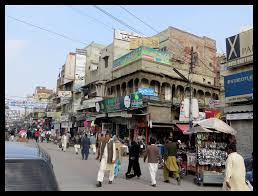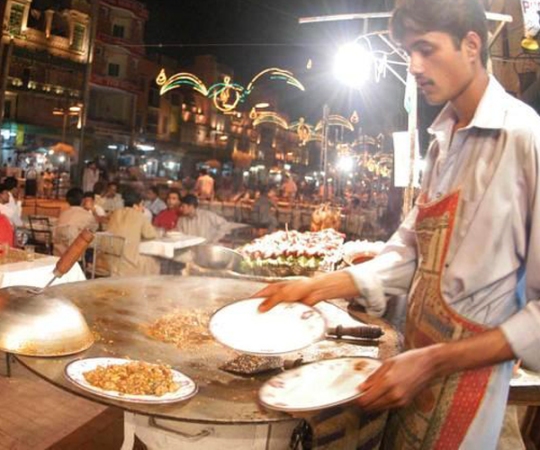How to install the app on iOS
Follow along with the video below to see how to install our site as a web app on your home screen.
Note: This feature may not be available in some browsers.
You are using an out of date browser. It may not display this or other websites correctly.
You should upgrade or use an alternative browser.
You should upgrade or use an alternative browser.
Old Lahore -- anarkali bazaar
- Thread starter ghazi52
- Start date
Khan vilatey
FULL MEMBER

- Joined
- Feb 11, 2020
- Messages
- 1,682
- Reaction score
- 5
- Country
- Location
I will never forget looking for my anrakali ( akhir Ravi ka pani piya hai, aik du dafa tu Aishq Hona hi tha) at the bazar and eating Churgah or tikka’s at the Resturant’s nearby............Lahore anarkali bazaar..............

.
.
.
.

The popular food street of Anarkali Bazaar, Lahore
.

.Old Lahore
.
.

jara lahore nahi wakhea o jamiya e nahi
Thank you so much for sharing these wonderful pictures and taking me back to my childhood!
K
ghazi52
PDF THINK TANK: ANALYST

- Joined
- Mar 21, 2007
- Messages
- 104,413
- Reaction score
- 106
- Country
- Location
Zamzama Gun on display in Lahore, Circa 1950's.

The gun was used by Ahmed Shah in the battle of Panipat, in 1761. After the battle, on his way back to Kabul, he left it at Lahore with his governor, Khawaja Ubed, as the carriage that was supposed to take the gun to Kabul was not ready. The other gun he took with him but that one was lost in passage through the Chenab.
In 1762, Dhillon Jat Ruler Maharaja Hari Singh Bhangi went into battle with Khawaja Ubed. Bhangi attacked the then-village of Khawaja Said two miles from Lahore (now part of the city of Lahore), where the Mughal governor Khawaja Ubed had his arsenal, and seized his artillery, arms and ammunition. Amongst the guns captured was the Zamzama Gun itself. It was renamed by its Sikh captors Bhangi Toap.
For the next two years, it lay in the Shah Burj of the Lahore Fort. Thereafter, Raja Lehna Singh and Maharaja Gujjar Singh Bhangi got hold of it and they gave it to Sandhawalia Jat Ruler Charat Singh Shukerchakia as his share in the spoils. The Bhangi Sardars thought that Charat Singh would not be able to carry this gun with him and it would remain with them. Contrary to their expectations, Charat Singh successfully carried this gun to his fort at Gujranwala.
From Charat Singh, Zamzama was snatched by the Chathas who took it to Ahmadnagar where it became a bone of contention between the brothers Ahmad Khan chatha and Pir Muhammad chatha. In the fight that ensued, two sons of Ahmad Khan and one of Pir Muhammad were killed. In this fight, Gujjar Singh Bhangi sided with Pir Muhammad. After the victory, the gun was restored to Gujjar Singh. After two years, the gun was wrested by Charat Singh Shukerchakia from whom it was once again snatched by the Pashtuns.
Next year, Raja Jhanda Singh Bhangi defeated the Pashtuns of Chatha and brought the gun to Amritsar. In 1802, Ranjit Singh, after defeating the Bhangis, got hold of the gun. He used it in the battles of Daska, Kasur, Sujanpur, Wazirabad and Multan. In the siege of Multan, the gun was badly damaged.
Zamzama was severely damaged due to its use in the aforementioned wars and it had to be brought back to Lahore, unfit for any further use. It was placed outside Delhi Gate, Lahore, where it remained until 1860. When in 1864, Maulawi Nur Ahmad Chishti compiled the Tahqiqati Chishti, he found it standing in the Baradari of the garden of Wazir Khan, behind the Lahore Museum.
In 1870, it found a new asylum at the entrance of the Lahore Museum, then located in the Tollinton Market. It was placed in this position on the occasion of the Duke of Edinburgh’s visit to Lahore in 1870. When the present building of the museum was constructed it was removed further west and placed opposite the University Hall.
Repaired in 1977, the cannon now rests on Mall Road (Shahrah-e-Quaid-e-Azam) with Pharmacy Department, University of the Punjab on one side, and National College of Arts (NCA) and Lahore Museum on the other.
The gun was used by Ahmed Shah in the battle of Panipat, in 1761. After the battle, on his way back to Kabul, he left it at Lahore with his governor, Khawaja Ubed, as the carriage that was supposed to take the gun to Kabul was not ready. The other gun he took with him but that one was lost in passage through the Chenab.
In 1762, Dhillon Jat Ruler Maharaja Hari Singh Bhangi went into battle with Khawaja Ubed. Bhangi attacked the then-village of Khawaja Said two miles from Lahore (now part of the city of Lahore), where the Mughal governor Khawaja Ubed had his arsenal, and seized his artillery, arms and ammunition. Amongst the guns captured was the Zamzama Gun itself. It was renamed by its Sikh captors Bhangi Toap.
For the next two years, it lay in the Shah Burj of the Lahore Fort. Thereafter, Raja Lehna Singh and Maharaja Gujjar Singh Bhangi got hold of it and they gave it to Sandhawalia Jat Ruler Charat Singh Shukerchakia as his share in the spoils. The Bhangi Sardars thought that Charat Singh would not be able to carry this gun with him and it would remain with them. Contrary to their expectations, Charat Singh successfully carried this gun to his fort at Gujranwala.
From Charat Singh, Zamzama was snatched by the Chathas who took it to Ahmadnagar where it became a bone of contention between the brothers Ahmad Khan chatha and Pir Muhammad chatha. In the fight that ensued, two sons of Ahmad Khan and one of Pir Muhammad were killed. In this fight, Gujjar Singh Bhangi sided with Pir Muhammad. After the victory, the gun was restored to Gujjar Singh. After two years, the gun was wrested by Charat Singh Shukerchakia from whom it was once again snatched by the Pashtuns.
Next year, Raja Jhanda Singh Bhangi defeated the Pashtuns of Chatha and brought the gun to Amritsar. In 1802, Ranjit Singh, after defeating the Bhangis, got hold of the gun. He used it in the battles of Daska, Kasur, Sujanpur, Wazirabad and Multan. In the siege of Multan, the gun was badly damaged.
Zamzama was severely damaged due to its use in the aforementioned wars and it had to be brought back to Lahore, unfit for any further use. It was placed outside Delhi Gate, Lahore, where it remained until 1860. When in 1864, Maulawi Nur Ahmad Chishti compiled the Tahqiqati Chishti, he found it standing in the Baradari of the garden of Wazir Khan, behind the Lahore Museum.
In 1870, it found a new asylum at the entrance of the Lahore Museum, then located in the Tollinton Market. It was placed in this position on the occasion of the Duke of Edinburgh’s visit to Lahore in 1870. When the present building of the museum was constructed it was removed further west and placed opposite the University Hall.
Repaired in 1977, the cannon now rests on Mall Road (Shahrah-e-Quaid-e-Azam) with Pharmacy Department, University of the Punjab on one side, and National College of Arts (NCA) and Lahore Museum on the other.
ghazi52
PDF THINK TANK: ANALYST

- Joined
- Mar 21, 2007
- Messages
- 104,413
- Reaction score
- 106
- Country
- Location
A view of the Mall, Lahore.
How calm it was!
Date: 1930

Probably Gate of the Lawrence Garden Lahore.

Sir John Lawrence's statue, who served as Governor-General and then Viceroy of India (1864 to 1869). His statue was once erected by the building of the Chief Court Lahore (High Court) which is visible in the background.

How calm it was!
Date: 1930
Probably Gate of the Lawrence Garden Lahore.
Sir John Lawrence's statue, who served as Governor-General and then Viceroy of India (1864 to 1869). His statue was once erected by the building of the Chief Court Lahore (High Court) which is visible in the background.
Saiful Islam
SENIOR MEMBER

- Joined
- Jul 23, 2013
- Messages
- 2,786
- Reaction score
- -7
- Country
- Location
The very first picture reminds me of victorian era streets in London
HostileInsurgent
BANNED

- Joined
- Oct 6, 2020
- Messages
- 2,516
- Reaction score
- -55
- Country
- Location
well yes but old delhi heritage is not as fiercely protected now as is in the case of Lahore but still old delhi has many areas of past
Old Delhi is still the same idk how...the govt have started rehabilitation of the old lahore and walled city ... they are making it awesome and beautiful while keeping its heritage touch
Old Delhi before during colonial era...
Old Delhi now
ghazi52
PDF THINK TANK: ANALYST

- Joined
- Mar 21, 2007
- Messages
- 104,413
- Reaction score
- 106
- Country
- Location
A 17th century painting of the Shalimar Garden.

Lahore’s famous Shalimar Garden was built in 1641 CE during the rule of fifth Mughal king, Shah Jahan. The land on which it was built belonged to ‘Mian’ family belonging to Punjab’s Arain tribe. The family was given the custodianship of the Garden by Shah Jahan.
The Mian Arian family retained the custodianship of the Garden for over 350 years until the site was taken over by the government of Pakistan in 1962 during the Ayub Khan regime.
Between 1965 and late 1970s, the Shalimar Gardens hosted a number of high-profile functions and receptions. It was also a favourite tourist resort. However, from the 1980s onward, the Garden began to deteriorate. Since 2001, it has been placed on UNESCO’s list of Endangered World Heritage Sites.
Lahore’s famous Shalimar Garden was built in 1641 CE during the rule of fifth Mughal king, Shah Jahan. The land on which it was built belonged to ‘Mian’ family belonging to Punjab’s Arain tribe. The family was given the custodianship of the Garden by Shah Jahan.
The Mian Arian family retained the custodianship of the Garden for over 350 years until the site was taken over by the government of Pakistan in 1962 during the Ayub Khan regime.
Between 1965 and late 1970s, the Shalimar Gardens hosted a number of high-profile functions and receptions. It was also a favourite tourist resort. However, from the 1980s onward, the Garden began to deteriorate. Since 2001, it has been placed on UNESCO’s list of Endangered World Heritage Sites.
Similar threads
- Replies
- 2
- Views
- 558
- Replies
- 17
- Views
- 1K
Latest posts
-
India launches missile attacks on Multiple locations in Pakistan,
- Latest: RaktimChandra
-
-
-
Why Pakistan’s JF-17 Thunder Is Outshining India’s Tejas on the World Stage
- Latest: FourMikeEcho
-
